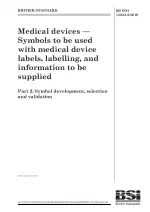BS ISO 15223-2:2010 PDF Download
Standard EN SampleMedical devices. Symbols to be used with medical device labels, labelling, and information to be supplied. Symbol development, selection and validation
Also Known As:
The ISO 15223 series of standards addresses symbols that can be used to convey information that is essential for the safe and proper use of medical devices. As such, in most regulatory domains the symbols are required to be presented with the device. The information can be required to be presented on the device itself, as part of the label or provided with the device.
This standard is in two parts , under the general title Medical devices - Symbols to be used with medical device labels, labelling and information to be supplied:-
- Part 1: General requirements
- Part 2: Symbol development, selection and validation
BS ISO 15223-2 specifies a process for developing, selecting and validating symbols for inclusion in ISO 15223-1. Its aim is to ensure that symbols included in ISO 15223-1 are readily understood by the target group.
If the symbol validation process detailed in BS ISO 15223-2 has been complied with, then the residual risks associated with the usability of a medical device symbol are presumed to be acceptable unless there is objective evidence to the contrary.
BS ISO 15223-2 is not restricted to symbols intended to meet regulatory requirements or specified in regulatory guidelines on labelling.
Many countries require that their own language be used to present textual information with medical devices. This presents problems to device manufacturers and users. When producing labelling in a number of different languages, manufacturers may have to increase the size of their package or label which potentially increases packaging waste, or they may have to compress the information which potentially compromises legibility. Devices labelled in a number of different languages can confuse users and delay the location of the needed information in an appropriate language. ISO 15223-1 proposes solutions to these problems through the use of internationally recognized symbols, with precisely defined meanings, that are independent of language.
While compiling the symbols for ISO 15223-1, the ISO/TC 210 committee decided that a systematic methodology for the development and presentation of symbols was needed. They began by drafting a “best practices” document, Guide to the development and registration of symbols for use in the labelling of medical devices.
When this guide was circulated to interested parties some regulatory authorities commented that they would have greater confidence in the use of symbols to replace text if the best practices set out in the Guide were in a standards document. Some of the best practices for symbols development and usage have been translated into normative requirements in ISO 15223.
Much of the information required on a medical device itself, as part of the label, or provided with the device constitutes information for safety within an integrated approach to risk management. As with any risk control measure, the manufacturer needs to verify the effectiveness of the information for safety before it can be accepted. The use of standardized symbols agreed by consensus on an international basis can address the confusion that users can experience when presented with labelling in a number of different languages.
However, the proliferation of symbols without control and harmonization is undesirable and detracts from the effectiveness of using symbols to convey information for safety. In addition, some users and regulatory authorities have concerns that the unrestricted use of symbols without validation can represent a hazard.
This part of ISO 15223 includes methods for validating those candidate symbols being proposed for inclusion in ISO 15223-1. It can also be used by manufacturers and regulators for validating symbols for use with medical devices, where they are not standardized.
This document has been prepared by ISO/TC 210 to influence the quality of symbols developed for use in labelling by establishing a process that addresses the need to ensure quality of symbols accepted in ISO 15223-1 by:
- Establishing need
- Providing guidance on development of symbols
- Carrying out testing to make sure that the candidate symbol is suitable for adoption and use.
When the processes detailed in this part of ISO 15223 have been carried out, the probability of misinterpretation of symbols accepted in ISO 15223-1 is reduced.
Contents of BS EN ISO 15223-2
- Scope
- Normative references
- Terms and definitions
- Principles for identification and development of new symbols
- Identifying the need for a symbol
- Symbols with horizontal applications
- Symbols for use within a restricted range of device types
- Process for selecting and validating symbols for inclusion in ISO 15223-1
- Initial evaluation
- Second evaluation
- Classification of risk
- Concept development
- Existence of other symbols
- Symbol design
- Evaluation
- Testing early symbol concepts
- Comprehension testing
- Memory testing
- Usability testing
- Acceptance criteria
- Symbols with no to low safety relevance
- Symbols with moderate to high safety relevance
- Information to be provided during the symbol development process for adoption of a symbol into ISO 15223-ISO/TC 145/SC 3 proposal for graphical symbols
- IEC/SC 3 proposal for graphical symbol form
- Bibliography
This first edition of ISO 15223-2, together with ISO 15223-1:2007, cancels and replaces ISO 15223:2000, which has been technically revised.
| Descriptors | Graphic symbols, Labelling (process), Marking, Medical instruments, Instructions for use, Product information, Medical equipment, Labels, Selection, Risk assessment, Symbols |
| ICS Codes | 01.080.20 - Graphical symbols for use on specific equipment 11.040.01 - Medical equipment in general |
| Language(s) | English |
| ISBN | 978 0 580 57532 7 |
| File Size | 931.8 KB |


